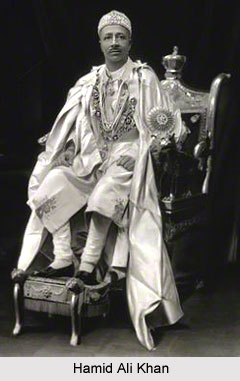 Hamid Ali Khan, formally known as Nawab Sayyid Hamid Ali Khan Bahadur, was a renowned ruler or Nawab of the princely state of Rampur. The princely state was later incorporated into the Indian state of Uttar Pradesh in the year 1949. He was born on 31 August 1875 and succeeded his father Nawab Muhammad Mushtaq Ali Khan Bahadur, KIH and ascended the throne after his father`s death in the year 1889. He belonged to the Rohilla Dynasty. Nawab Sayyid Hamid Ali Khan Bahadur ruled over the territory of Rampur from the year 1889 to 1930. As he was a minor at the age of thirteen years when he ascended the throne of the princely state of Rampur, Hamid Ali ruled the territory under regency until the year 1896. After reaching the age of majority, the 9th Earl of Elgin, Victor Bruce invested him with complete ruling powers.
Hamid Ali Khan, formally known as Nawab Sayyid Hamid Ali Khan Bahadur, was a renowned ruler or Nawab of the princely state of Rampur. The princely state was later incorporated into the Indian state of Uttar Pradesh in the year 1949. He was born on 31 August 1875 and succeeded his father Nawab Muhammad Mushtaq Ali Khan Bahadur, KIH and ascended the throne after his father`s death in the year 1889. He belonged to the Rohilla Dynasty. Nawab Sayyid Hamid Ali Khan Bahadur ruled over the territory of Rampur from the year 1889 to 1930. As he was a minor at the age of thirteen years when he ascended the throne of the princely state of Rampur, Hamid Ali ruled the territory under regency until the year 1896. After reaching the age of majority, the 9th Earl of Elgin, Victor Bruce invested him with complete ruling powers.
Rule of Hamid Ali Khan
Due to his various progressive efforts during his reign, his personal salute was increased from 13 guns to 15 guns. This was done particularly as Sir Hamid Ali Khan`s army provided distinguished service in the Middle East, Afghanistan and German East Africa during the First World War. He was a strong supporter of higher education and took several steps to spread education. He generously contributed for the establishment and development of many educational institutes and colleges across the Indian subcontinent, including the Aligarh Muslim University and the Lucknow Medical College. He also increased the number of educational institutions within the princely state of Rampur.
Personal Life of Hamid Ali Khan
Nawab Sayyid Hamid Ali Khan Bahadur died on 20th June 1930 after a reign of 41 years, at the age of 54, and was succeeded by Sir Raza Ali Khan Bahadur, who was his son.
Titles of Hamid Ali Khan
Hamid Ali Khan, Nawab of the princely state of Rampur held many titles through out his reign. These are discussed below-
* Nawabzada Sayyid Hamid Ali Khan Bahadur (1875- 1889)
* His Highness Ali Jah, Farzand-i-Dilpazir-i- Daulat-i-Inglishia, Mukhlis ud-Daula, Nasir ul-Mulk, Amir ul- Umara, Nawab Sayyid Hamid Ali Khan Bahadur, Mustaid Jang, Nawab of Rampur (1889- 1895)
* Captain His Highness Ali Jah, Farzand-i-Dilpazir-i- Daulat-i-Inglishia, Mukhlis ud-Daula, Nasir ul-Mulk, Amir ul- Umara, Nawab Sayyid Hamid Ali Khan Bahadur, Mustaid Jang, Nawab of Rampur (1895- 1897)
* Major His Highness Ali Jah, Farzand-i-Dilpazir-i- Daulat-i-Inglishia, Mukhlis ud-Daula, Nasir ul-Mulk, Amir ul- Umara, Nawab Sayyid Hamid Ali Khan Bahadur, Mustaid Jang, Nawab of Rampur (1897- 1908)
* Major His Highness Ali Jah, Farzand-i-Dilpazir-i- Daulat-i-Inglishia, Mukhlis ud-Daula, Nasir ul-Mulk, Amir ul- Umara, Nawab Sayyid Sir Hamid Ali Khan Bahadur, Mustaid Jang, Nawab of Rampur, GCIE (1908- 1909)
* Lieutenant-Colonel His Highness `Ali Jah, Farzand-i-Dilpazir-i- Daulat-i-Inglishia, Mukhlis ud-Daula, Nasir ul-Mulk, Amir ul- Umara, Nawab Sayyid Sir Hamid Ali Khan Bahadur, Mustaid Jang, Nawab of Rampur, GCIE (1909- 1910)
* Colonel His Highness `Ali Jah, Farzand-i-Dilpazir-i- Daulat-i-Inglishia, Mukhlis ud-Daula, Nasir ul-Mulk, Amir ul- Umara, Nawab Sayyid Sir Hamid Ali Khan Bahadur, Mustaid Jang, Nawab of Rampur, GCIE (1910- 1911)
* Colonel His Highness Ali Jah, Farzand-i-Dilpazir-i- Daulat-i-Inglishia, Mukhlis ud-Daula, Nasir ul-Mulk, Amir ul- Umara, Nawab Sayyid Sir Hamid Ali Khan Bahadur, Mustaid Jang, Nawab of Rampur, GCIE, GCVO (1911- 1921)
* Colonel His Highness Ali Jah, Farzand-i-Dilpazir-i- Daulat-i-Inglishia, Mukhlis ud-Daula, Nasir ul-Mulk, Amir ul- Umara, Nawab Sayyid Sir Hamid Ali Khan Bahadur, Mustaid Jang, Nawab of Rampur, GCSI, GCIE, GCVO (1921- 1928)
* Major-General His Highness Ali Jah, Farzand-i-Dilpazir-i- Daulat-i-Inglishia, Mukhlis ud-Daula, Nasir ul-Mulk, Amir ul- Umara, Nawab Sayyid Sir Hamid Ali Khan Bahadur, Mustaid Jang, Nawab of Rampur, GCSI, GCIE, GCVO (1928- 1930)
Honours of Hamid Ali Khan
Nawab Sayyid Hamid Ali Khan Bahadur was honoured a number of times, these are as follows-
* Delhi Durbar Gold Medal (1903)
* Knight Grand Commander of the Order of the Indian Empire- GCIE (1908)
* Delhi Durbar Gold Medal (1911)
* Knight Grand Cross of the Royal Victorian Order- GCVO (1911)
* Knight Grand Commander of the Order of the Star of India- GCSI (1921)



















